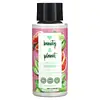What's inside
What's inside
 Key Ingredients
Key Ingredients

No key ingredients
 Benefits
Benefits

 Concerns
Concerns

 Ingredients Side-by-side
Ingredients Side-by-side

Water
Skin ConditioningSodium Laureth Sulfate
CleansingCoco-Betaine
CleansingGlycol Distearate
EmollientSodium Chloride
MaskingDimethicone
EmollientParfum
MaskingCocamide Mipa
EmulsifyingSodium Benzoate
MaskingHexylene Glycol
EmulsifyingSalicylic Acid
MaskingGuar Hydroxypropyltrimonium Chloride
Skin ConditioningCarbomer
Emulsion StabilisingCetyl Alcohol
EmollientSodium Cocoyl Amino Acids
CleansingBehentrimonium Methosulfate
Quaternium-33
Potassium Dimethicone PEG-7 Panthenyl Phosphate
Skin ConditioningBenzyl Benzoate
AntimicrobialSodium Sarcosinate
Propylene Glycol
HumectantLimonene
PerfumingBenzyl Alcohol
PerfumingArginine
Masking2-Oleamido-1,3-Octadecanediol
Skin ConditioningHydrolyzed Soy Protein
HumectantLinalool
PerfumingFumaric Acid
BufferingHydrolyzed Vegetable Protein Pg-Propyl Silanetriol
Skin ConditioningPhenoxyethanol
PreservativeTetrasodium EDTA
Potassium Sorbate
PreservativeSodium Hydroxide
BufferingCitric Acid
BufferingWater, Sodium Laureth Sulfate, Coco-Betaine, Glycol Distearate, Sodium Chloride, Dimethicone, Parfum, Cocamide Mipa, Sodium Benzoate, Hexylene Glycol, Salicylic Acid, Guar Hydroxypropyltrimonium Chloride, Carbomer, Cetyl Alcohol, Sodium Cocoyl Amino Acids, Behentrimonium Methosulfate, Quaternium-33, Potassium Dimethicone PEG-7 Panthenyl Phosphate, Benzyl Benzoate, Sodium Sarcosinate, Propylene Glycol, Limonene, Benzyl Alcohol, Arginine, 2-Oleamido-1,3-Octadecanediol, Hydrolyzed Soy Protein, Linalool, Fumaric Acid, Hydrolyzed Vegetable Protein Pg-Propyl Silanetriol, Phenoxyethanol, Tetrasodium EDTA, Potassium Sorbate, Sodium Hydroxide, Citric Acid
Ingredients Explained
These ingredients are found in both products.
Ingredients higher up in an ingredient list are typically present in a larger amount.
Linalool is a fragrance and helps add scent to products. It's derived from common plants such as cinnamon, mint, citrus, and lavender.
Like Limonene, this ingredient oxidizes when exposed to air. Oxidized linalool can cause allergies and skin sensitivity.
This ingredient has a scent that is floral, spicy tropical, and citrus-like.
Learn more about LinaloolParfum is a catch-all term for an ingredient or more that is used to give a scent to products.
Also called "fragrance", this ingredient can be a blend of hundreds of chemicals or plant oils. This means every product with "fragrance" or "parfum" in the ingredients list is a different mixture.
For instance, Habanolide is a proprietary trade name for a specific aroma chemical. When used as a fragrance ingredient in cosmetics, most aroma chemicals fall under the broad labeling category of “FRAGRANCE” or “PARFUM” according to EU and US regulations.
The term 'parfum' or 'fragrance' is not regulated in many countries. In many cases, it is up to the brand to define this term.
For instance, many brands choose to label themselves as "fragrance-free" because they are not using synthetic fragrances. However, their products may still contain ingredients such as essential oils that are considered a fragrance by INCI standards.
One example is Calendula flower extract. Calendula is an essential oil that still imparts a scent or 'fragrance'.
Depending on the blend, the ingredients in the mixture can cause allergies and sensitivities on the skin. Some ingredients that are known EU allergens include linalool and citronellol.
Parfum can also be used to mask or cover an unpleasant scent.
The bottom line is: not all fragrances/parfum/ingredients are created equally. If you are worried about fragrances, we recommend taking a closer look at an ingredient. And of course, we always recommend speaking with a professional.
Learn more about ParfumSodium Benzoate is a preservative. It's used in both cosmetic and food products to inhibit the growth of mold and bacteria. It is typically produced synthetically.
Both the US FDA and EU Health Committee have approved the use of sodium benzoate. In the US, levels of 0.1% (of the total product) are allowed.
Sodium benzoate works as a preservative by inhibiting the growth of bacteria inside of cells. It prevents the cell from fermenting a type of sugar using an enzyme called phosphofructokinase.
It is the salt of benzoic acid. Foods containing sodium benzoate include soda, salad dressings, condiments, fruit juices, wines, and snack foods.
Studies for using ascorbic acid and sodium benzoate in cosmetics are lacking, especially in skincare routines with multiple steps.
We always recommend speaking with a professional, such as a dermatologist, if you have any concerns.
Learn more about Sodium BenzoateWater. It's the most common cosmetic ingredient of all. You'll usually see it at the top of ingredient lists, meaning that it makes up the largest part of the product.
So why is it so popular? Water most often acts as a solvent - this means that it helps dissolve other ingredients into the formulation.
You'll also recognize water as that liquid we all need to stay alive. If you see this, drink a glass of water. Stay hydrated!
Learn more about Water